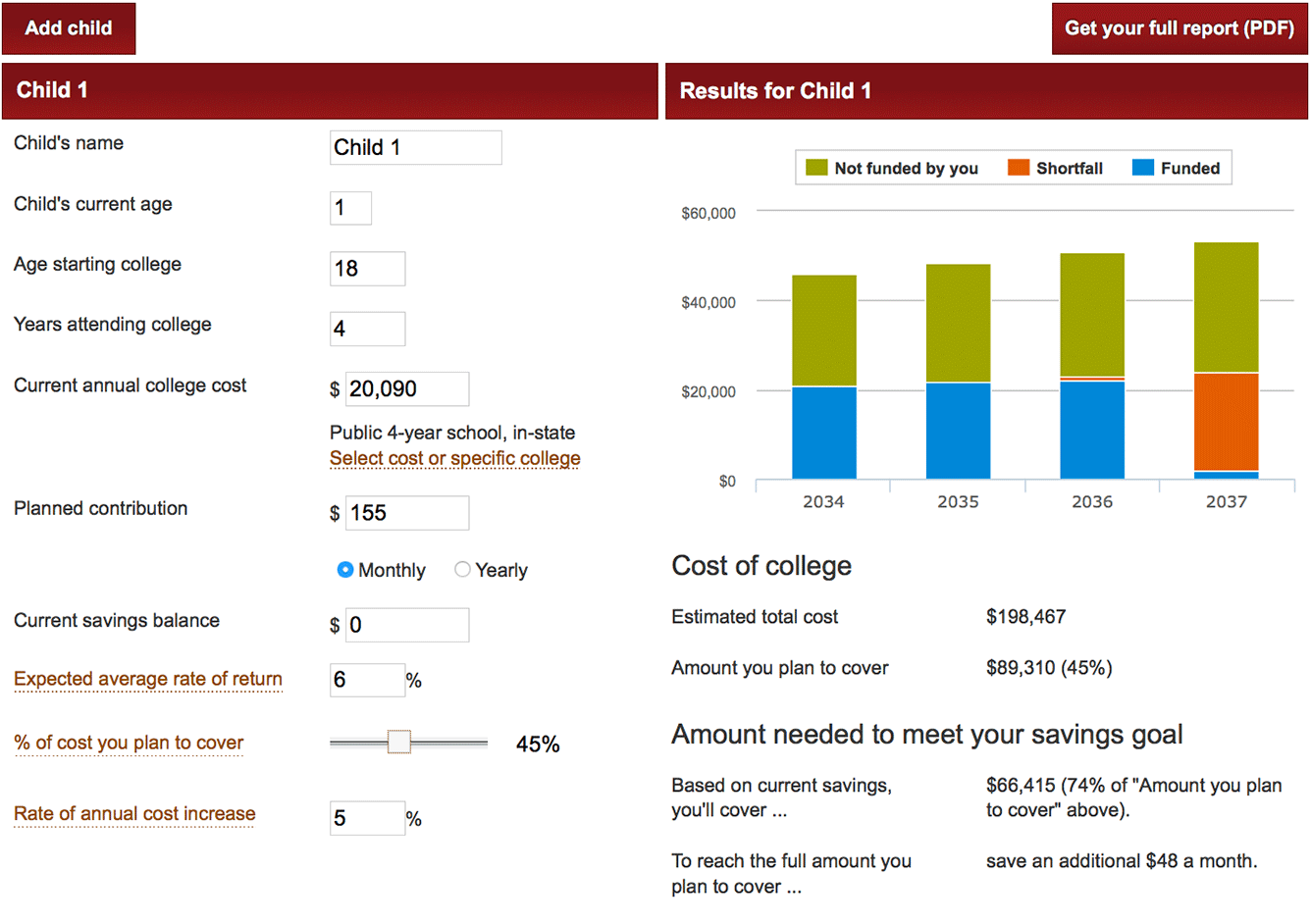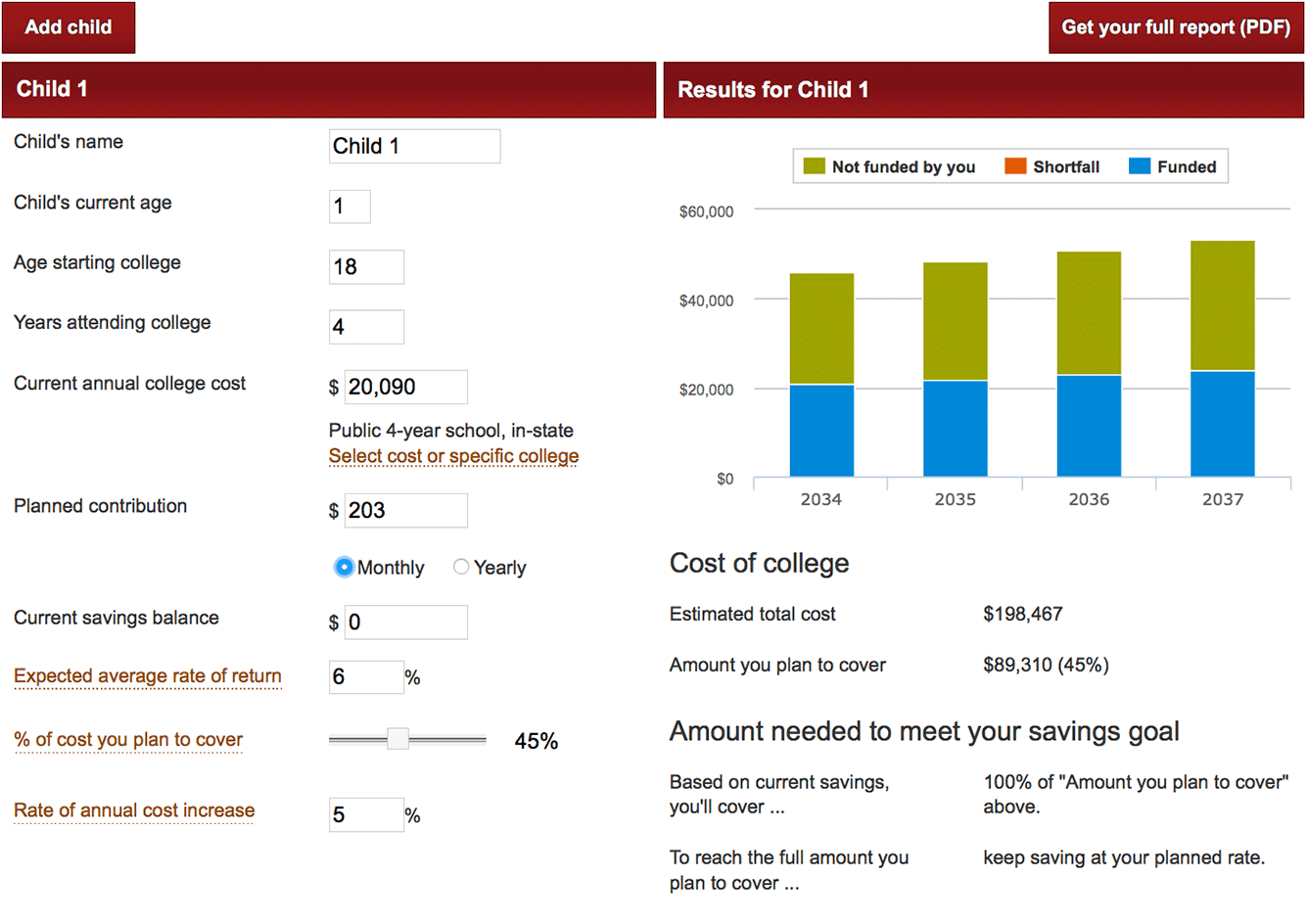Whether you've just opened your 529 account or you've been saving for some time, you've taken an important step in planning for your child's future. To stay on track, it makes sense to periodically revisit your savings goals to see if you need to make any adjustments.
Sallie Mae's "How America Pays for College 2016" reports that families who have a plan to save for college save up to 3.5 times more than those who don't have a plan. Correspondingly, the students in families who plan end up borrowing 33% less than those who don't plan.
To help you stay on track with your savings plan, you may want to use our tool to evaluate whether you're likely to reach your goals or you need to make some changes.
Use our college savings planner
How to use the planner
Start by plugging your student's details into the tool—name, current age, age when he or she will start college, and how many years he or she is expected to attend.
You can also select the type of school (if it's known) by choosing Select cost or specific college under Current annual college cost and then picking the appropriate school type from the dropdown. This will give you an estimated current annual cost for that type of school. You can also search by state or by the name of a particular institution.
Once you've entered these details, you'll need to input your "Planned contribution" and select "Monthly" or "Yearly." If you've been saving for some time or if you started out with a lump-sum amount, indicate the amount you've already saved under "Current savings balance."
For the "Expected average rate of return," the tool's assumption is that your accounts will grow 6% a year on average. For the "Rate of annual cost increase," the assumption is that college costs will rise by 5% a year. However, you can enter a different rate for each.
When you choose the "% of cost you plan to cover," it's important to understand that most families don't end up covering 100% of the total cost of college. In fact, Sallie Mae's "How America Pays for College 2016" reports that on average 34% of the total cost of college is paid for by grants and scholarships.
If you choose to cover 40% to 50% of the total cost of college, indicate the chosen amount as "% of cost you plan to cover." You can also use whatever figure makes sense for your situation. You can then view the results under Cost of college, where you'll see the "Estimated total cost" as well as the "Amount you plan to cover."
Under Amount needed to meet your savings goal, you'll see whether you're on track or need to make adjustments. This section will show you how much you'll cover based on your current savings rate. The planner will also show you what changes you should consider making to your "Planned contribution" amount to reach the full "Amount you plan to cover."
Example 1: Before increasing the contribution amount
As you can see in the hypothetical example below, this account owner was a bit off track in working toward his or her goal of covering 45% of the "Estimated total cost" of college at a public four-year, in-state school. Under Cost of college, you can see that the account owner needs $89,310 to cover the 45%. However, under Amount needed to meet your savings goal, it shows that based on current savings, he or she will cover just $66,415. That shortfall of $22,895 is also shown in orange on the bar graph.

In the same example, under Amount needed to meet your savings goal, the planner recommends that "To reach the full amount you plan to cover …" the account owner should "save an additional $48 a month."
If the account owner chooses to make that adjustment, it's simple for him or her to log on to the account and select Contribute. The account owner can then follow the directions to make a onetime contribution, sign up for recurring contributions, or increase an existing recurring contribution.
Example 2: After increasing the contribution amount
In the image below, you can see the difference that contributing just a little bit more each month can make toward meeting your goals. In this case, the hypothetical account owner increased the "Planned contribution" by the recommended $48 per month.
With this adjustment, the bar graph no longer shows a shortfall, and the results under Amount needed to meet your savings goal indicate that the account owner will now have 100% of the amount he or she plans to cover. The planner's recommendation is to "keep saving at your planned rate."

Running reports and checking your progress
Once you've entered all the information, the tool also allows you to download your report by selecting Get your full report (PDF). You can then save the report to your computer or print it. You may want to run a few different scenarios and then compare the reports to see what plan is most likely to meet your personal needs and best help you reach your goals.
We recommend returning to the planner periodically to check your progress. You might want to do this once a year or anytime you make changes, such as the type of school you're targeting, the amount you're contributing, or the frequency of contributions.
Taking the time to run the numbers on a regular basis will help you know if you're ahead, falling behind, or right on track in reaching your college savings goals.
This tool isn't intended to constitute, nor does it constitute, tax advice. You should consult your own tax advisor for more information on the tax implications of investing in a 529 plan based on your own particular circumstances.

